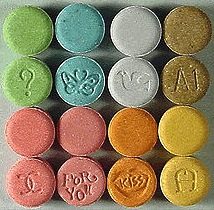 Classification: Entactogenic Amphetamine
Classification: Entactogenic Amphetamine
Common Names/Nicknames: E, X, XTC, Adam, Eve, love, lover’s speed, upper’s, clarity
Active Compound: Methylenedioxymethamphetamine (MDMA), methylenedioxyamphetamine (MDA), methylenedioxyethylamphetamine (MDE)
Found in: Ecstasy tablets
Mode of Consumption: Ingestion, insufflation, injection
DEA Scheduling/Legal Status (in US): Schedule I, illegal in all states
Effects:
Euphoria, psychedelia, analgesia, hyperactivity, altered consciousness, calmness, pleasurable sensitivity to physical stimulation
Risks:
Acute: Anxiety, paranoia, hypersensitivity, dehydration, hyperthermia, muscle twitching, seizures, coma, permanent brain damage, fatal overdose
Chronic: Depression, anxiety, dental damage, significant memory impairment, decreased brain function, liver damage, muscle damage, brain damage
Dangerous Drug Combinations:
Potentially fatal combination with antidepressants that are monoamine oxidase (MAO) inhibitors.
Special Considerations:
Approximately half of all purported ecstasy tablets contain no ecstasy. Common substitutes include caffeine, dextromethorphan, amphetamine, ephedrine, and ketamine.
And remember, if somebody may need help, play it safe and call for medical assistance.
“Students may bring an intoxicated or drug-impaired friend to University Health Services or to a hospital, or seek assistance from College residential life staff or HUPD, and by doing this, neither they nor the friend will face disciplinary action from the College for having used or provided alcohol or drugs.”
The Amnesty Policy
Harvard College Student Handbook
Sources:
Buzzed: The Straight Facts About the Most Used and Abused Drugs from Alcohol to Ecstasy (Third Edition), by Cynthia Kuhn, Scott Swartzwelder, and Wilkie Wilson. Published 2008 by W. W. Norton & Company.
National Institute on Drug Abuse (NIDA), part of the National Institute of Health (NIH) of the U.S. Department of Health and Human Services.
http://www.nida.nih.gov/DrugPages/
U.S. Drug Enforcement Agency (DEA), part of the U.S. Department of Justice.
Erowid Organization

